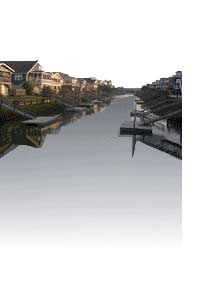I saw the sky last night. It was the sky I have seen before
only in planetaria, but the bluest skies Ive ever seen are not in Seattle; they are in Arizona.
We had arrived in Tucson
earlier in the day, and Jacki Mieler from the Arizona Office of Tourism, had arranged for us to have supper at the Lazy K
Ranch a huge dude ranch made larger by its contiguity with the Saguaro National
Park at the base of the Tucson Mountains.
For me, dude ranch conjures up Billy Crystal and a mid-life
crisis, but the Lazy K was a surprise. In operation for more than seventy years, the Lazy K offers mountain climbing and rappelling
down a 65-foot drop directly behind the main house. We saw the spotlighted mountain from a yoga garden that overlooks pastures
filled with more than fifty Lazy K horses. From time to time, the yoga garden is also used for what seems to be southern Arizonas
most popular pastimes: stargazing.
| Rugged Mountains |

|
Debbie one of the partners in the Lazy K, showed us around,
explaining about bucking out the baby bulls twice a week to give young riders practice before going on to compete in rodeos.
It also provides a chance to see which bulls will buck.
After supper, we stopped briefly to watch line-dancing
lessons before moseying out to the front porch to admire the fields of prickly pear and saguaro cacti, many of which appear
to be hundreds of years old. There we clambered into the back of a buckboard that would take us to Stardance, the Lazy Ks
adjoining sister property.
Out of the pitch darkness and beyond the clip clop of the
horses, appeared a fairyland of twinkling lights, beyond which shone the lights of downtown Tucson. At the Stardance Pavilion,
we collected refreshments at the hospitality cart and went outside to gather around the Celestron 2000 that seems to be a
standard feature where people gather in Tucson. A local astronomer pointed the
telescope at the stars and proceeded to amaze us, beginning with a look at the Owl Cluster. Even my wonted constellation-visualizing
impairment yielded and I clearly saw the outline of an owl in flight, his two eyes glowing millions of miles away. We also
got a close-up look of Mars (which looked to be more butterscotch than angry red), and good old M57, the Ring Nebula that
looks remarkably like a doughnut.
For a denizen of the light-polluted east coast, these were
astounding sights.
Clip clopping back to the Lazy K, we felt, more than saw, saguaro cacti looming
over us. This, I thought, is the way it looked to ranchers a century ago as they trusted their horses to see the way home
through the unmitigated darkness of an Arizona night.
| Mount Kitt |

|
| Observatories |
But the next day, we would see the sun.
Morning brought another sunny Arizona day. We spent
the first two nights at Westward Look, an elegant and tastefully understated resort. At more than 650 square feet, our rooms
were the largest hotel accommodations in Tucson. Outside our windows, prickly
pears bore ripe red fruit, and some of the cactus paddles had turned pink, as they do from time to time. Bougainvillea blossomed
among other less recognizable blooms in the courtyard, and we assembled for our trip to the sun at least to Mount
Kitt, the National Science Foundations observatory with the worlds largest array
of optical telescopes.
On the winding road to Mount
Kitt, I was surprised at the beauty of the mountains, with which I dont usually
associate Arizona. They appear in the background of cowboy movies, but until
actually ascending them it is difficult to appreciate their majesty. The summit of Mount
Kitt provides a delightful panorama of the surrounding mountains, and, at an elevation
of 7,000 feet, the temperature was a breezy ten degrees below Tucsons mid-nineties.
(But, its a dry heat.)
The focal point of the visitors center was a large poster
with a pale disk covering most of it .When our guide, program coordinator Robert Wilson, joined us, he pointed to the poster,
explaining that it was a screen showing a live image of the sun, reflected from the telescope above us. I looked more closely,
thinking that the observatory must need funds to just ignore the marred area in the lower right quarter of the screen. Silence
proved to be my friend when Robert mentioned that we were looking at a spectacular image of a group of sunspots. I had heard
about sunspots, but thought them some kind of metaphor, or at least a vague spattering of ephemeral sun gases. Even as a child I knew that you couldnt look directly at the sun except at night but he we were looking
at what looked like frog eggs, but were, in fact, dark nuclei (umbra) some 1,500
2,000 degrees cooler than the surrounding translucent mass (penumbra) of the sun.
It was humbling to note that each of the sunspots was much larger than the tiny model of earth displayed next to the suns
image.
I had heard sun spots blamed for interference in radio
transmissions, but I didnt realize that they might last anywhere from a few days to a few weeks, as hot gasses bubble up to
the photosphere.
Located on the Tohona OOdham (Dwellers of the Desert) Reservation,
Mount
Kitts National Optical Astronomy Observatory (NOAO) is operated by the National
Science Foundation and the Associated Universities
for Research in Astronomy. NOAO has the largest array of optical telescopes in the world, with seven additional telescopes
planned for the near future. The clear skies, relatively free of the light pollution of big cities, allow unimpeded observation
about 250 nights of the year.
After the tour, Robert showed us to a steel dome the size
of a small waiting room, where students manipulate the 16 Meade telescope. We got a chance to push the button to rotate the
dome so that we could look at the sun through a hydrogen alpha filter that allowed us to focus on the sunspots.
Students come and manipulate the Meade telescope in a smaller
observatory building, capturing videotape of their solar investigation, while staff videotape the student doing so. The videos
presented to the students as mementos of the trip..
Although we looked through the eyepiece, scientists and
students usually sit at a computer console from which they remotely control the telescope and record the images.
Through this telescope the sun seemed reddish, and we observed
movement of the sunspots and the prominences or gas trails that follow magnetic lines. Although I have enjoyed a mild interest
in the skies, visiting Mount Kitt was
transformational in moving me from an observer to a participant in exploring the universe. I can only imagine what it means
to young students.
Adults are not forgotten. For less than fifty dollars,
adults can control a 36 telescope to explore the night sky. (The size refers to the diameter of the main mirror.) An advanced
program, in which two people are treated as visiting astronomers, offers the chance to have access to a telescope overnight.
Upon our descent from the observatory, we had just enough
time to for a brief visit to San Xavier de Bac Mission, a strikingly beautiful eighteenth century church gleaming in
the Sonora Desert sun. The ornate interior
includes hand-carved icons of angels and saints in an intricate reredos that soars to the ceiling. An effigy of St. Francis
is covered with miniature tokens, mostly tiny metallic representations of human legs. A sign asked worshipers not to visit
with St. Francis during Mass.
| San Xavier de Bac |
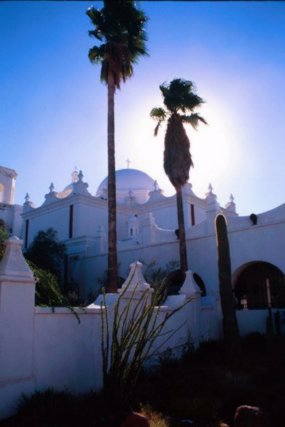
|
| Mission Church |
| San Xavier Mission |

|
Although we didnt spend much time at the Mission, we were
happy to have the opportunity to enjoy the visual feast in the southern Arizona
desert.
On our return to Westward Look, we were treated to a tour
of the grounds, including the chefs garden, the butterfly garden, the homey Wellness
Center, and the original family home from which the dude ranch and this modern
resort grew.
In the evening we enjoyed a special dinner in which each
course was matched with a wine from Australias Torbeck Vineyard.
As is the entire resort, food is prepared with a sense of place. Oddly enamored with the prickly pear, I sampled a prickly
pear margarita before dinner. A little too sweet for my taste, it certainly was a colorful alternative to the usual tequila
vehicle.
| Prickly Pear in Bloom |
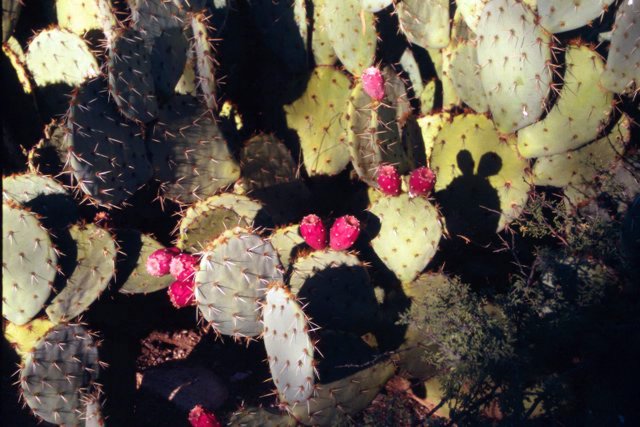
|
| Buffalo Steak and Purple Peruvian Potatoes |
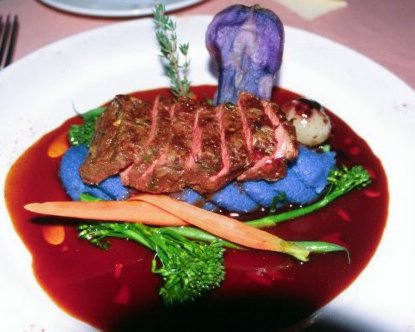
|
| Westward Look Resort, Tucson |
The next morning we were off to Whipple Observatory,
another of the half-dozen observatories in the Tucson area. Originally, a multiple
mirror telescope (MMT) with six coordinated mirrors provided the equivalent of a four-foot mirror. The current 6.5-meter mirror
is housed in a four-and a half-story square building on Mount Hopkins,
8,550 feet above sea level.
The Whipple Observatory, operated jointly by the Smithsonian
Institution and the University of Arizona, is about an hours drive from the visitors center, up narrow twisting road, often
with nothing between the government bus and a tumbling, terrifying, fiery death not that it ever occurred to me.
Whipple has not only a huge 6.5-meter reflecting telescope,
but also a 10-meter reflecting telescope designed to detect and trace the source of high energy gamma rays . While I didnt
get the idea that any of us non-scientists really understood what that is about, we did have a wonderful time taking photographs
of the surreal images provided by the collection of mirrors.
The top of Mount
Hopkins had been leveled to make a space for the 550-ton building that houses the
6.5 meter telescope. Unlike most observatories, this one is not in a dome with telescope and slit tracking in tandem the advance
of stars across the night sky. Instead, one wall and half the roof of the structure slides open, and the entire building rotates
on railroad tracks to follow the stars.
| Whipple Observatory |
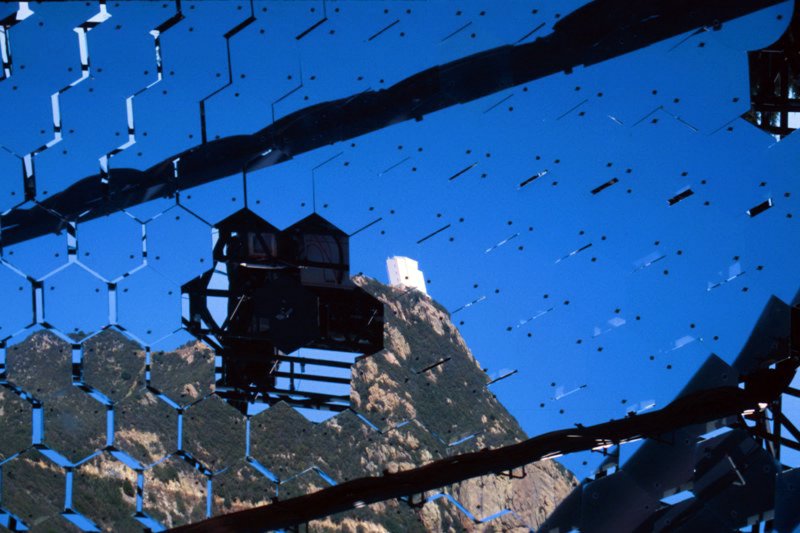
|
| Reflected in Gamma Ray Telescope |
We were disappointed that, despite the length of our five-hour
visit and the idleness of the telescopes, we were never allowed the opportunity to look at an image, either through the lens
or by computer, probably the most rewarding aspect of our visit to Mount Kidd.
The amount of information gathered at these observatories
is staggering. One of the engineers proudly mentioned that scientists there had been able to gather information simultaneously
from 252 galaxies, illuminating how difficult it is to imagine the magnitude of the universe.
Insignificant as we may be, we were getting hungry, so
we headed south to our next stop, the Rio Rico Resort near Nogales.
Initially, Rio Rico disappointed me, even though several
top management folks greeted us with lemonade and welcomes. I felt that this resort was trying too hard. Unlike Westward Look,
it didnt radiate a sense of its desert environment. Indeed, one of our party remarked that we had found an oasis as the sprinkler
system watered lush lawns, abundant oleander, and a golf course, designed by Robert Trenton Jones.
Any lingering disappointment melted away at dinner, when
Executive Chef Warren Weekes and his able assistant, Adolfo Aris Cabrera created surprise after delectable surprise at the
tapas bar.
| Whipple Observatory |
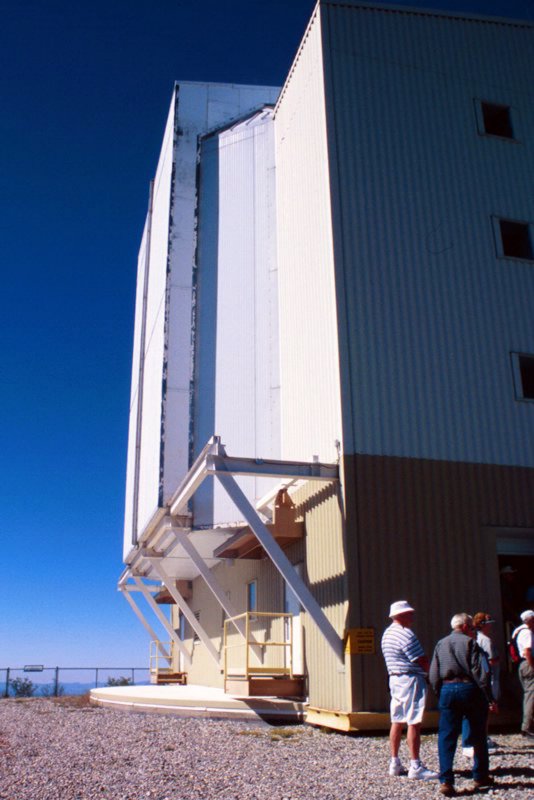
|
| Entire Building Rotates |
The pan-seared goat cheese with sweet balsamic reduction
was far different from the usual earthiness of goat cheese. Among the succulent prime rib and sesame duck, and the range of
eminently satisfying palate pleasers, two stood out: medjool dates served warm with prosciutto and cabazola was melt-in-your-mouth
medley of bleu cheese reigned in by the dates sweetness, and Caramba! The giant Mexican shrimp wrapped in bacon and grilled
in a soy-prickly pear sauce must be the hors doeuvre favored by the gods. Every dish was a victory.
In the morning we had the opportunity to talk more with
Chef Warren, when he met us in the lobby for a tour of Nogales Sonoma., in Mexico. Warren, who is married to a woman from the Mexican
side of the line, has gone native in more than his cooking. He clearly identifies with the people of Nogales
and celebrates their culture as much as their food.
In Nogales Sonoma, we stopped for brunch at El
Toro, a colorful and popular restaurant that serves traditional peasant food. There we enjoyed a sampler of earthy
foods such as pigskin stewed in tomatillos, enchiladas, tamales, and quesadillas. After we had eaten, Warren
brought out tortilla chips so that we could try the traditional warm salsa, which I thought similar to a marinara sauce with
roasted peppers and garlic, and salsa fresca, a course topping which Americans usually call by the misnomer pico de gallo.
A third dish was less familiar: large cubes of pickled beef liver and potatoes. Those who tried said it tasted like pickled
beef liver. I intend to live out my life without verifying what that means.
From El Toro, we toured the disparate
neighborhoods and stopped at Leys Supermarket, which seemed almost anachronistic in this old town. At Leys the most important
product appears to be security. We were first accosted in the produce department by a clerk and plain-clothes security, because
one of our group was wearing a backpack. She was escorted to the front of the store to check the bag or return it to the van.
While the rest of us felt vague sympathy, two more employees approached because several of us had camera bags, also verboten.
Happy to escape a body cavity search, we returned our camera bags to the van, although I was uneasy about leaving undeveloped
film in the Mexican heat.
Back at the scene of the potential crime, Warren
explained the different varieties of chile, their relative heat on the Scoville Scale, and how they are best used in cooking.
From the produce section, we went on to watch customers await preparation of the tortillas, ordered by the kilo, and Warren
explained how to select a good tequila, including reposado and añejo.
After the supermarket, we briefly toured the affluent section
of Nogales Sonada, although the narrative seemed too much directed toward titillation, imbued with drug connections and violence.
More interesting was the discussion of the local economy
and the impact of the mercadora on the locals. Companies such as Samsonite, Swingline,
and Q-tip that have crossed the border for a workforce to whom the $8.00 a day in pay with a like amount in benefits quadrupled what they otherwise earn and a fraction of what it would cost the companies a few miles
north.
Twice a year, Rio Ricos Bread Across Borders program delivers
goods, including food, clothes, and school supplies to hundreds of families and orphans in Nogales
Sonora.
We stopped for lunch a Las Herraduras, which was billed
as a Mexican feast, but the sad truth was that we had over indulged too recently at El Toro, and none
of us was ready to eat. Las Herraduras was more upscale than El Toro, but it offered only a limited
menu of carne asada (Barbecued beef) pork butt and pork carnitas, which were close
enough to tacos that I would have considered them just another version with different meat fillings. After some cool drinks
and a brief tour of the kitchen, Warren ordered up some very tasty carnitas for
the road.
The line for the border was long, so we left Ricardo to
fend for himself with the van and leapt into the frenetic activity of Nogales
just south of the border. Like any border town, it was rife with native trinkets and crafts. Aggressive vendors attempted
to lure passers-by to their stalls instead of their neighbors. Some were in complete earnest, while others seemed to caricature
themselves with offers of goldfor your neighbors wife or Rolex watches almost real!
Warren and Ricardo run the tours about once a week. For
about $60, safe transportation into and around Mexico, food,
beverages, knowledgeable guides, and a chefs view of produce and drinks, I think it quite the bargain.
We said good-bye to Chef Warren and made a dash for Patagonia
Lake, where park ranger Steve Haas awaited us.
| Breakfast and Cerveza at El Toro |

|
| Nogales, Mexico |
| El Toro |

|
| Nogales, Mexico |
In a state where only 13 percent of the land is privately
owned and the question of water supply imbedded in ones awareness, Patagonia Lake is like an oasis in
the desert. Well, I suppose that it is an oasis in the desert. The lake was formed in the late sixties when Sonoita Creek,
which supplies it, was dammed. With ranger Steve, the parks manager, at the wheel, we toured the lake in a pontoon boat while
volunteer John Webb described our surroundings. Steve mentioned that budget cutbacks have made loyal volunteers such as John
critical to properly operating the park.
We were surprised and delighted at the abundance of wildlife
around the lake, with blue herons taking flight as we hugged the shore, one obligingly swallowed a large catfish before our
very eyes for a photo op. Around us swam dozens of whiteface coots. From time to time along the shore, we spotted some of
the small deer that roam the park.
After our leisurely tour of the lake and a brief visit with a snake that Steve
houses in the nature center, we headed for the hills and Hacienda des Sueños, the bed and breakfast where we would spend the
night - and one of the most wonderful houses I have had the pleasure to visit.
| A Blue Heron enjoys Fresh Fish |
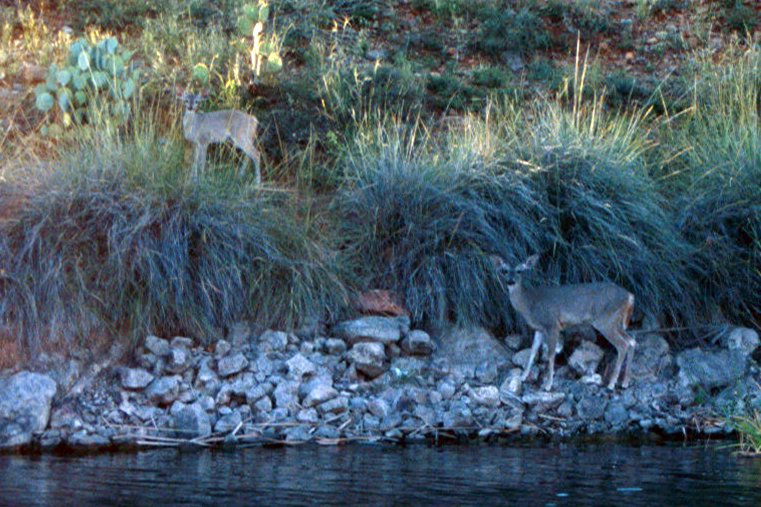
|
| Patagonia Lake |
I like rambling houses, and Hacienda des Suenos rambles
more than a travel writer with an audience. Although Patagonia, as much an art colony as a town, is only about an hour from Tucson
(Everything seems to be about an hour from Tucson!) it is a suburb of a miniature
version of Mayberry. The center of town is a few scattered restaurants and a former railroad station that now serves as a
Town Hall. The hacienda is in a remote section of Patagonia. While it seems to be out of sight or hearing
of any possible neighbor, it is actually only a few minutes from the town and The Velvet Elvis.
In addition to serving delicious fare that happens to all be organic, The Velvet
Elvis is a story unto itself. Yes, it does contain a rendering of Elvis on velvet, but that came after the restaurant was
named. Proprietor Cecilia San Miguel decided that Velvet Elvis was merely a whimsical
name. It was later that a friend donated the fuzzy portrait of The King. As it happens, I didnt even notice the painting when
we first entered because the life-size sculpture of the Archangel Michael that guarded the door had my undivided attention.
The sword-wielding archangel was carved out of a single block of cedar in Guadalajara
for the Mission of San Miguel across the town common and down a few houses from the Velvet Elvis.
Cecilia has purchased the mission for a no-smoking bar
(in Patagonia!) where artists are painting representations of religions of the world on the original
adobe walls from 1915. The mission, still undergoing renovation, is a beehive of activity with masons and carpenters and artists
working side-by side to complete the project. What appeared to be a baptismal font in front of the entrance was being built
while we were there, and a serpent undulated along the length of the top of a long wall.
But we were talking about the Velvet Elvis, where Cecilia
painted pictographs on the floor because an inner voice told her This is the voice of the ancient ones.
Organic food, pictographs of the ancient ones, images of Elvis, a shrine to
the Virgin Mother, a cedar archangel, and paintings of Native American women on the walls are only the surface of Cecilias
story.
The lovely and vivacious proprietor was a recent widow
when she encountered a couple at an airport. Learning that Cecilia had no attachments in Seattle,
the woman told her that she should go to Patagonia, Arizona.
While visiting her family in Latin America, Cecilia kept hearing the womans advice. So, when she returned
to the States in April 1997, she went to look at this Patagonia, and soon after she was setting up
shop with Elvis.
| Velvet Elvis Proprietor Serves Organic Pizza |
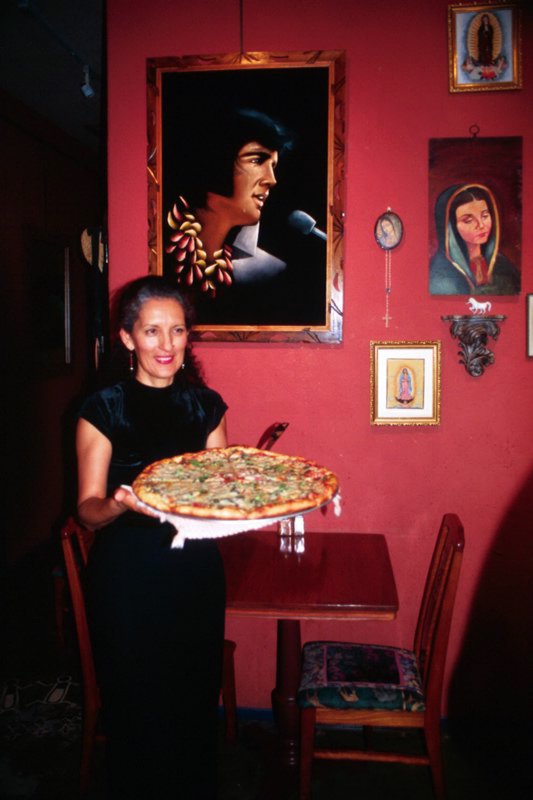
|
| Patagonia, Arizona |
| The Archangel Michael Guards the Entrance |

|
| Velvet Elvis; Patagonia, Arizona |
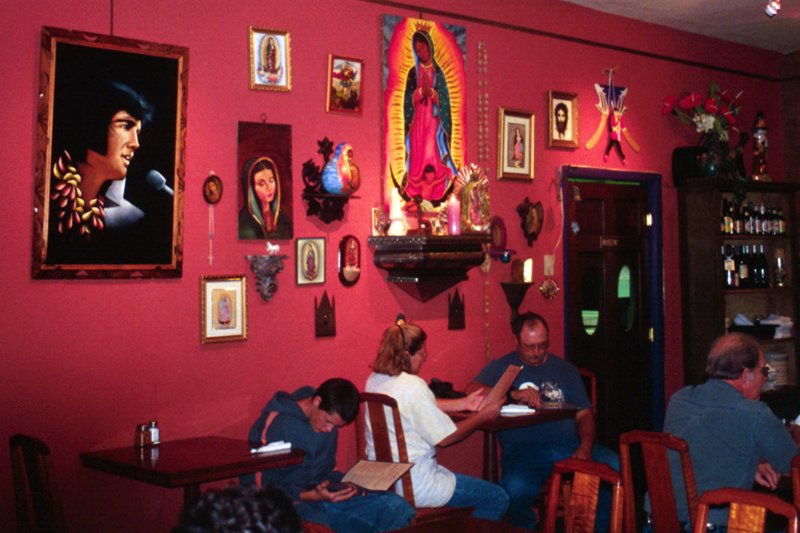
|
| Varid Iconography at Velvet Elvis |
The little restaurant is filled with locals and a few outsiders,
some of whom have made the trek to Patagonia
just to eat at the VE. And why not? It has something for everyone. The organic food is for the sophisticated palate, says
Cecilia. The Native American spirit expresses my strong connection to Native Americans. The images of the virgin mother are
gifts. She is the patron saint of Mexico, Our Lady of Guadalupe.
And the food? It is worth the trip, you bet.
The next morning we headed for Kartchner Caverns
State Park. The newest section was not yet open to the public, but we were lucky
enough to join a practice tour.
The caves were nice, almost as beautiful as Virginias
Luray Caverns. There were some formations I didnt recall having seen before and I dont mean the tidy piles of bat guano that
greeted us from place to place.
These caves, a relatively recent discovery, were kept secret
while the young men who found them and the family that owned the property figured out how to protect them and maybe earn a
few dollars along the way. The result is impressive conservation measures.
After touring the visitors center, a non-polluting electric
tram takes visitors to the cave entrance, a convenience for the elderly and infirm who happen to be exploring caves (The walled,
paved trails are entirely wheelchair accessible), but it also protects the landscape and keeps visitors relatively dust free.
Dust or lint, we learned, can be a hazard to caves, introducing
algae to the environment. So how do you keep lint out of the caves? I am ever so glad you asked.
As we entered
the opening of the cave, we were misted by a fine spray overhead. In the 90-plus degree heat, I was thankful, but the spray
also moderates the arid air and rinses off or dampens down any free dust and lint before we enter the first of four sealed
conservation chambers designed to keep humidity in and arid desert air out.
Nonetheless, when we entered the first chamber, it felt
like a steam bath. Like canal locks, everyone must be in and the first door resealed before the second door is opened.
As we entered each chamber, we experienced a greater degree
of comfort until we finally reached the caverns, at a constant 68 degrees, with 99 percent humidity.
The cement paths either have very high curbs or very low
walls. Because lint can be a major problem, any that visitors might bring in despite the extensive measures in place can be
sluiced by pumping water through the trails after the last of the days visitors have left. Not forgetting that the caverns
are in the desert, the water is then recycled to water plants around the visitors center.
The cave offered many familiar formations, crenellated
columns and bacon and eggs (which we have seen done better at Luray), but the indirect lighting and use of flashlights maintained
the atmosphere and integrity of the caves better than most. Although the guide told us that the bizarre curlicue helectite
formations are not uncommon, I dont recall seeing them. Here they were profuse.
One other aspect of the conservation efforts relates to
the guano mentioned earlier. To protect the 800-1000 bats that live in the cave, the caverns are closed during maternity and
nursing period, usually from mid-April to mid-October. It is gratifying to see such efforts to protect nature, both the caves
and their residents.
The caves behind us, we wanted to try some of that Arizona
wine we hear so much about, so we headed for our first winery. Fortunately, we had noted wine connoisseur Michael Vaughn along
with us from Toronto. Left to my own devices, I choose a wine based on how easily
the cap unscrews. Well, possibly my palate is slightly more sophisticated than that, but Michael was my guide, and I made
sure to have the same wine that he was tasting to try to put the language he used to describe it into a context I could understand.
It didnt work terribly well. I was more impressed that he could tell the degree of acidity with remarkable accuracy and instantly
determine not only what varieties of grapes constituted the varietals, but whether the oak was English, French or a combination,
and how long it had aged in each. My judgments were more along the lines of, Oh, that's nice or I don't like that.
| Callaghan Vineyards |
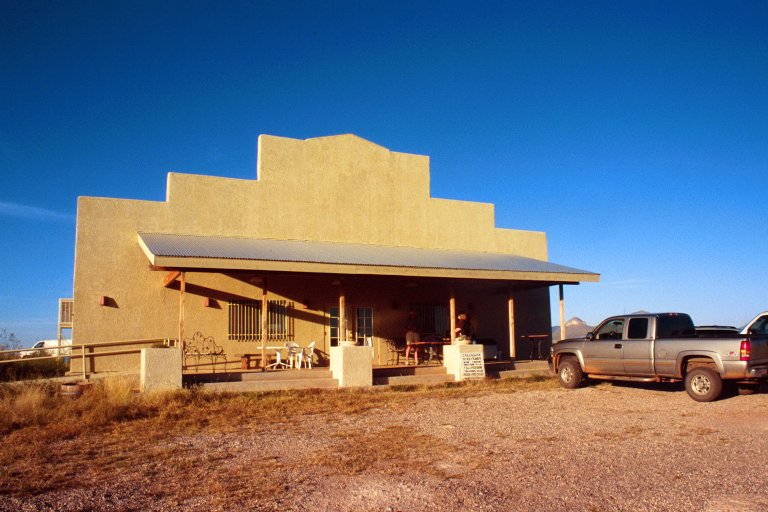
|
| Sonoita, Arizona |
We sampled wines from several vineyards that afternoon,
but we ended at Callaghan Vineyards where owner Kent Callaghan and his friend Al Buhl from Dos Cabezos Vineyards, about eighty
miles away, greeted us on the porch. Of his warehouse cum store.
Kent apologized for wearing a soiled tee shirt and shorts.
He had just finished picking grapes. As tired as he had to be, the vintner became increasingly animated as he discussed each of his wines. Michaels enthusiasm outmatched him. The bored resignation that
had registered before was replaced by growing excitement as his nose plunged deeper into his glass for longer periods of time.
I know rapture, and this was it.
Oh, thats nice, I contributed. Kent and Michael kept talking.
Kevin also had a few bottles of Dos Cabezos wines on hand,
and Al joined the excitement as Kent and Michael became increasingly
animated in their wine exultation. (Maybe the amount of wine we had tried contributed to the excitement. Even Michael had
foregone swish and spit for savor and swallow.)
It was dark when we dragged Michael out of Callaghans,
and we had added a number of bottles of wine to the blue agave tequila, reposado, and anejo that had wandered into the van.
Thus reinforced, we headed for the Café Sonoita, a deservedly
popular restaurant with a varied and sophisticated menu and an equally sophisticated wine list. The prime rib stuffed with
jalapenos was deservedly popular, and the pork chops were done with a prickly pear glaze. Heather, from the Arizona Office
of Tourism, and I. the major prickly pear consumers, high-fived over yet another use for our favorite
cactus fruit, but I finally settled on the more pedestrian filets mignon. Sometimes a man just needs to have meat and potatoes.
My personal highlight was the thick block of chewy fudge
brownie topped with ice cream and drizzled with chocolate sauce. In a realm where I am truly a connoisseur, I had found paradise.
In the Arizona
desert. Who would have believed.?
After dinner our group separated for the first time, half
to Hacienda Sueros and half to the Sonoita Inn. The Hacienda people won. I stayed at the Inn because
a colleague wanted to use my trusty laptop to transfer some digital photos to a CD.
The Sonoita Inn was built by a horse.
When Secretariat (born in Virginia,
thank you.) won the Triple Crown in 1973Margaret Carmichael, a co-owner, used part of the winnings to build the barn like
structure with adobe bricks made by handicapped residents of Tucson. Nonetheless,
it was a barely utilitarian accommodation compared with Hacienda Sueros, where we joined our colleagues for breakfast.
| Breakfast at Casa Sueros |

|
| Sonoita, Arizona |
While I am still partial to the rambling Casa de Sueños,
this B&B is a modern unmistakably southwestern beauty, impeccably designed and decorated, with four guest rooms along
one side of a courtyard with a Celestron 2000. The owners live on the other side.
Breakfast was French toast baked in a Dutch oven with blueberries
lining the bottom. Along with fresh orange juice, savory sausages, cut-up fruit, and excellent coffee, it was an entirely
satisfying meal.
Unfortunately, it was my last meal in Arizona, at least
for that trip. With the kind of hospitality, food, scenery and variety of activities in this beautiful state, I dont think
that it will be too long before I return with my family. I have already managed another quick visit in the interim.
The author wishes to thank the Arizona Office of
Tourism for its generous support and assistance.
|
